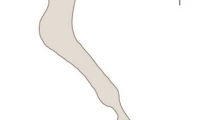Abstract
The macrophytes of Lake Bled were studied from 1987 to 1990. Three main factors influenced the decline of the aquatic vegetation in the lake during that period: (1) reduced light in the littoral zone due to an increase in phytoplankton (2) grazing by herbivorous fish and waterfowl, and (3) direct human impact.
Similar content being viewed by others
References
Anderson, M. R. & J. Kalff, 1988. Submerged aquatic macrophyte biomass in relation to sediment characteristics in ten temperate lakes. Freshwat. Biol. 19: 115–121.
Best, E. P. H., 1981. The submerged aquatic macrophytes in Lake Maarsseveen I: species composition, spatial distribution and productivity: Hydrobiol. Bull. 15: 72–81.
Best, E. P. H., 1982. The aquatic macrophytes of Lake Vechten. Species composition, spatial distribution and production. Hydrobiologia 95: 65–77.
Carignan, R. & J. Kalff, 1980. Phosphorus sources for aquatic weeds: water or sediments? Science 207: 987–989.
Carignan, R., 1982. An empirical model to estimate the relative importance of roots in phosphorus uptake by aquatic macrophytes. Can J. Fish. aquat. Sci. 39: 243–247.
Carignan, R., 1985. Nutrient dynamics in a littoral sediment colonized by the submersed macrophyte Myriophyllum spicatum. Can. J. Fish. aquat. Sci. 42: 1303–1311.
Carpenter, S. R. & D. M. Lodge, 1986. Effects of submersed macrophytes on ecosystem processes. Aquat. Bot. 26: 341–370.
Crivelli, A. J., 1983. The destruction of aquatic vegetation by carp. Hydrobiologia 106: 37–41.
Collins, C. D., R. B. Sheldon & C. W. Boylen, 1987: Littoral zone macrophyte community structure: distribution and association of species along physical gradients in Lake George, New York, USA Aquat. Bot. 29: 177–194.
Gaberščik, A. & A. Martinčič, 1982. Productivity of the reed (Phragmites communis Trin.) in Lake Bled, Slovenia, Yugoslavia. Biol. vest. 30/1: 25–44.
Gophen, M., 1982. Unusually dense watermilfoil (Myriophillum spicatum L.) vegetation in the southern basin of Lake Kinneret (Israel) in 1979. Aquat. Bot. 13: 307–315.
Grace, J. B. & R. G. Wetzel, 1978. The production biology of Eurasian watermilfoil (Myriophyllum spicatum L.): a review. J. aquat. Plant. Mgmt. 16: 1–11.
Haslam, S. M., Ch. Sinker & P. Wolseley, 1975. British water plants. Field Stud. 4: 243–351.
den Hartog, C., J. Kvet & H. Sukopp, 1989. Reed. A common species in decline. Aquat. Bot. 35: 1–4.
Hutchinson, G. E., 1975. A treatise on Limnology, vol III, Limnological Botany. Wiley & Sons, N.Y., 660 pp.
Lachavanne, J.-B., R. Juge, A. Noetzlin & J. Perfetta, 1985. Ecological and chorological study of Swiss lake aquatic plants. A basic method to determine the bioindicator value of species. Verh. int. Ver. Limnol. 22: 2947–2949.
Lawson, G. J., 1985. Cultivating reeds (Phragmites australis) for root zone treatment of sewage. Contract report to the water research centre ITE project 965.
Martinčič, A. & F. Sušnik, 1969. Mala flora Slovenije. Cankarjeva založba v Ljubljani.
Ostendorp, W., 1989. ‘Die-back’ of reeds in Europe — a critical review of literature. Aquat. Bot. 35: 5–26.
Prejs, A., 1984. Herbivory by temperature freshwater fishes and its consequences. Envir. Biol. Fish. 10: 281–196.
Radinja, D., 1983. Alpine lakes in Yugoslavia. Geogr. Iugoslavica 5: 37–46.
Radziej, J., E. Brylinsky & T. Krzywosz, 1988. Macrophytes regeneration after their destruction by grass carp in Lake Dgal Wielki at the background of fishery management. Congress of Ichthyology Budapest, 15.–18.8. 1988.
Rejic, M., J. Sketelj, 1973. Radovi i efekti na sanaciji Bledskog jezera (Restoration measures and their effects in Lake Bled). Vodoprivreda 25: 363–370.
Rismal, M., 1980. The judgement of individual methods for sanitation of Lake Bled (in slovene). Grad. vest. 2/3: 34–46.
Rorslett, B., 1985. Death of submerged macrophytes-actual field observations and some applications. Aquat. Bot. 22: 7–19.
Sketelj, J., M. Rejic, 1962. Preliminarno poročilo o preiskavi Blejskega jezera (Preliminary report on the research of Lake Bled). Grad. vest. 41: 61–64.
Vrhovšek, D., G. Kosi, M. Kralj, M. Bricelj & M. Zupan, 1985. The effect of lake restoration measures on the physical, chemical and phytoplankton variables of Lake Bled. Hydrobiologia 127: 219–228.
Wetzel, R. G., 1990. Land-water interfaces: Metabolic and limnological regulators. Verh. int. Ver. Limnol. 24: 6–24.
Author information
Authors and Affiliations
Rights and permissions
About this article
Cite this article
Urbanc-Berčič, O., Blejec, A. Aquatic macrophytes of Lake Bled: changes in species composition, distribution and production. Hydrobiologia 262, 189–194 (1993). https://doi.org/10.1007/BF00010883
Accepted:
Issue Date:
DOI: https://doi.org/10.1007/BF00010883




